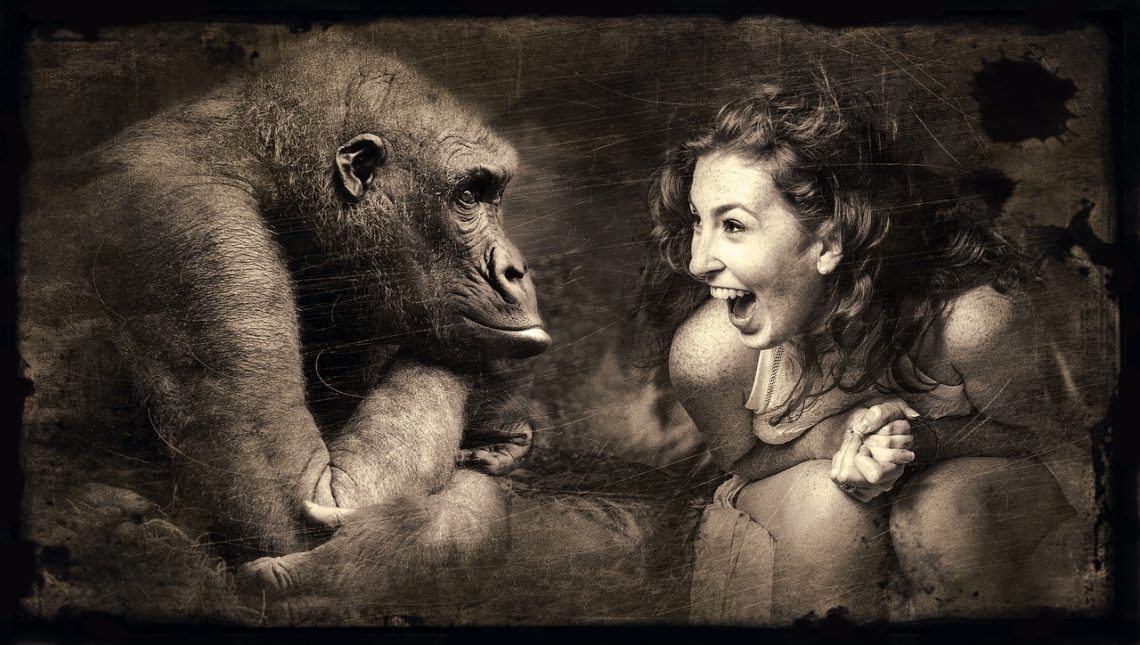by Caleb Rauch
Laughter is a real puzzler in terms of evolutionary study. What possible reproductive benefits could come from hooting like a deranged owl? Why is this behaviour instinctive, while something like hunting needs to be taught? While vocalizations from play fighting are nothing special in the realm of animals, only humans and a few primate relatives explicitly create laughter when they find something amusing or to communicate complex messages. We respond almost unconsciously to social cues that promote laughter and end up laughing even when things aren’t funny. It’s a complex phenomenon, but the question is simple: what causes laughter?
In the book The Humor Code, author and behaviour scientist Peter McGraw suggests laughter evolved from the panting that animals spout when play-fighting. This panting serves an important social cue: to let everyone know that it is playing, and nobody is going to get their windpipe removed. Primates make similar noises when tickled, showing a link between the two.
This effect was extended as humans formed social groups that increased in size. Pedro Marijuán and Jorge Navarro, researchers at the Instituto Aragonés de Ciencias de la Salud use chimp socialization as an example. They spend up to 20% of their time grooming in pairs, allowing for bonds to be strengthened between individuals. However, this isn’t a great solution for large groups. Conversation, however, allows for up to ten or so individuals to easily partake in socializing. Marijuán and Navarro propose laughing is a way for individuals to demonstrate their involvement in larger conversations. It evolved as a “release for pent-up intellectual momentum,” just as blushing is simply the brain relieving excess flow to the cerebellum through a facial artery (arXiv).
This is where things get interesting. Just like blushing, the social significance of laughing was built up over time. A study by Robert Provine showed that modern laughter tends to occur at phrase breaks in speech, instead of spontaneously occurring in the middle of sentences. This is called the punctuation affect, where laughter acts as—you guessed it—punctuation. Furthermore, laughter has evolved as a polite response, rather than an actual response to something humourous. Provine’s study took around 1,200 observed laughter incidents and their context, and only around 20% of them were following something remotely joke-like (Provine). This raises a puzzling question: why have we evolved an inherent need to share what we find funny with others, and even unconsciously feign amusement?
In the 19th century, a French physician by the name of Guillaume Duchenne conducted experiments with electrodes, attempting to zap faces into smiles and laughs by stimulating muscles. He found he could evoke a simple smile, but a real laugh—what occurs when we find something truly amusing—remained elusive. This expression is now known as Duchenne laughter, which he believed was “only put at play by the sweet motion of the soul.”
A hundred years or so later, a study was published by Matthew Gervais in the 2005 Quarterly Review of Biology that attempted to track the evolution of laughter. Based off Duchenne’s findings, they found that this “real laughter” evolved between 2 or 3 million years ago as a natural extension of the primal play-fighting noises to let others know that everything was okay (McGraw and Warner, Why Do Humans Laugh? ). Many hundreds of thousands of years after that, and after the development of language, we learned to mimic this behaviour to take advantage of its effects.
Our ancestors did this for the same reasons we do: sometimes for mutual benefit, sometimes for the opposite. As Gervais and Wilson put it in their paper, “non-Duchenne laughter came to occur in aggressive, nervous, or hierarchical contexts, functioning to signal, to appease, to manipulate, to deride, or to subvert.” This was a huge step forward in terms of social complexity and gives real insight into the early stages of development for our current social dynamics.
Other primates have evolved this sort Duchenne laughter and humor as well. Koko, a gorilla that has learned over 1,000 ASL signs, once tied her trainer’s shoelaces together and signed “chase,” and chimps, bonobos, and gorillas all have laughter-like responses to tickling and play (McGraw and Warner, Do Animals ). However, humans remain the only primate who have utilized the social significance of laughing for benefit through imitation of it.
Laughter makes up a large part of human society. Beyond its evolutionary origins, many studies have been done on the psychological benefits of it, but quite a few key factors of the act remain mysteries to us. Knowing the reasons and science behind laughter could lead to important developments in antidepressants and other related medicines, and granting us a greater picture of who we are as humans as well.
Works Cited
arXiv. “The Evolutionary Origin Of Laughter.” MIT Technology Review , MIT, 22 Oct.
2012, www.technologyreview.com/s/421480/the-evolutionary-origin-of-laughter/. McGraw, Peter, and Joel Warner. “Do Animals Have a Sense of Humor?” Slate Magazine ,
Slate Group, 26 Mar. 2014, www.slate.com/articles/arts/culturebox/features/2014/the_humor_code/do_animals_h ave_a_sense_of_humor_new_evidence_suggests_that_all_mammals.html.
—. “Why Do Humans Laugh? (Hint: It’s Rarely Because Something Is Funny.).” Slate Magazine, Slate Group, 25 Mar. 2014, www.slate.com/articles/arts/culturebox/features/2014/the_humor_code/why_do_hum ans_laugh_the_evolutionary_biology_of_laughter.html.
Provine, Robert. “The Science of Laughter.” Psychology Today , Sussex Publishers, 1 Nov. 2000, www.psychologytoday.com/articles/200011/the-science-laughter.





